In the winter season of cold, snow and holiday music, the North American bird breeding and nesting season seems months away. It’s not until the trees begin to bud and flowers bloom that the birdsong fills the air.
And that’s true. But not for great horned owls.
Winter is the time to enjoy the great horned owl breeding season–a time when these charismatic birds are much easier to see and hear.
It’s the hooting season.
Don a winter cap and head out to your local park or walking trail to enjoy one of the season’s coolest spectacles. Here’s what you need for your next owl outing.
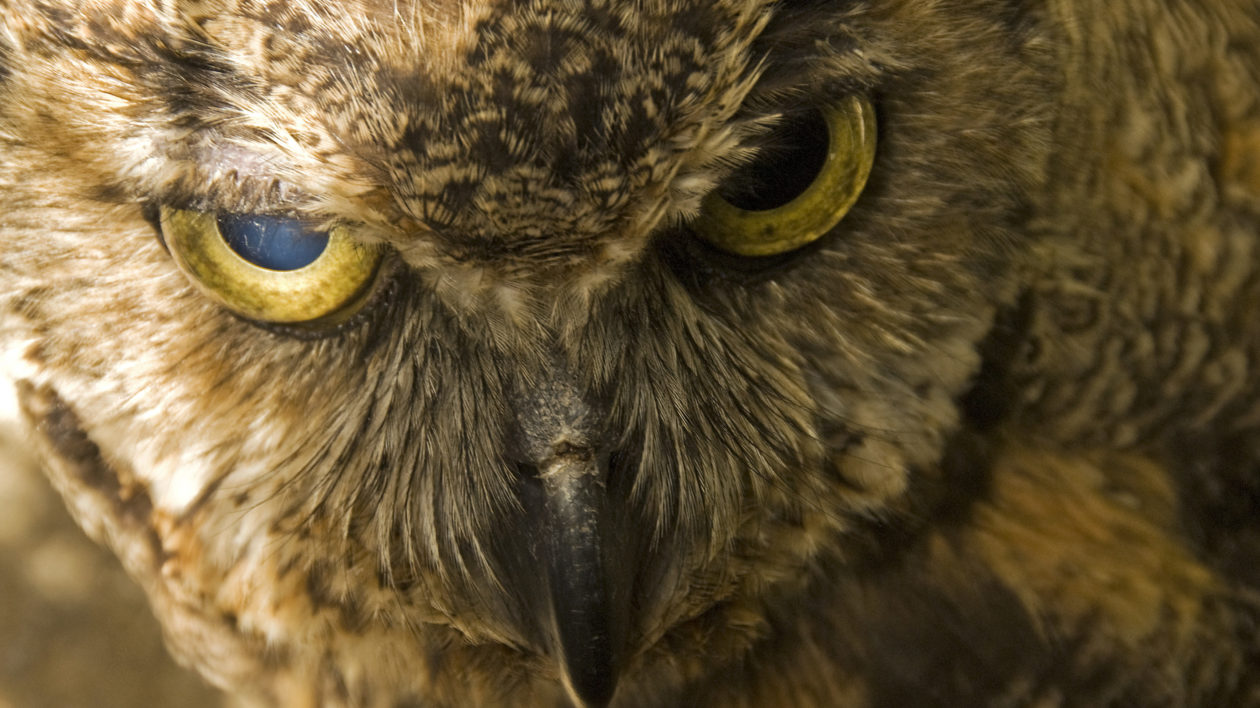
Into Owl Territory
The great horned owl, of course, is one of the most recognizable birds in the Americas, with its pointy feather tufts (the “horns”) and large fluffy appearance.
This is the prototypical “wise old owl,” and the owl of cartoons and children’s books.
It’s also incredibly adaptable, found from Canada to Patagonia, and most places in between. It is at home in desert and wetland, forest and prairie. And it also has no trouble thriving around people: you can find them in parks, farms, small woodlots, suburbs and cities.
Despite this, they’re not always easy to spot due to their nocturnal habits. But at this time of year, in the right location, a chorus of hoots provides the soundtrack to dawn and dusk.
That’s because, around October, male great horned owls begin setting up territories. Most great horned owls mate for life, but in the fall the pair begin a courtship display, loudly calling to each other.
Become a Member
Make a lasting impact for nature when you join The Nature Conservancy
The great horned owl’s hoot is pretty much unmistakable, although ornithology web sites often describe it in different ways. A common hooting pattern is a longer hoooooot, followed by two or three shorter hoots.
And these owls have a range of other vocalizations, too, some of which sound like barks or a screeching cat. (Cornell’s All About Birds site features some great audio of these different calls).
The owls continue setting up their territory this month, and begin setting up a nest.
They’ll use an abandoned nest previously used by a red-tailed hawk, squirrel or other critter. Come January, they’ll begin setting in the nest–far earlier than most other birds.
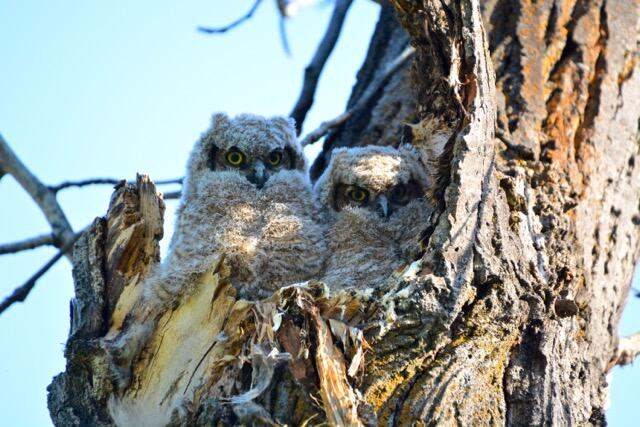
Why Do Owls Nest So Early?
Nesting early naturally entails some risk. Eggs must be kept warm and incubated, which can be a challenge when the temperature is in the single digits and snow is falling.
Female owls stay on the nest for prolonged periods (and when they leave to hunt, the male will take over).
If the eggs become too cold, they won’t hatch. This is why most birds wait until temperatures are warm and mild.
So: why nest early?
Owls are large birds. It takes them longer to grow and mature than, say, a songbird.
Young great horned owls must also master complex hunting maneuvers. They are equipped with superb senses – researchers have found that a great horned owl can hear a mouse rustling at 900 feet – but hunting still involves learning, trial and error.
Early hatching means they’re ready to practice their flying and hunting skills when the weather is mild and prey is abundant.
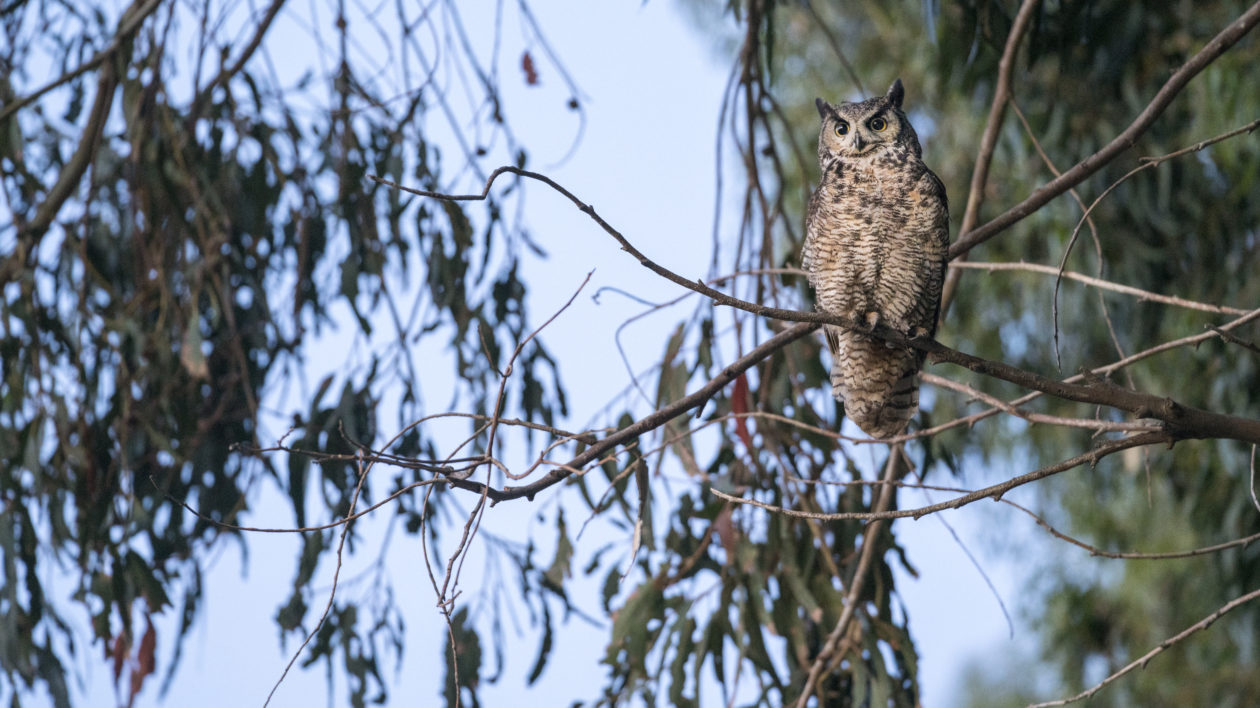
Enjoying the Owl Show
There’s likely a great horned owl territory near you. Now you just need to find it.
While owls can live in a variety of habitats, you won’t find them just anywhere. Focus on the edges. Owls prefer to have a good vantage point – a place where they can see out over the terrain.
Trees that overlook an open area are ideal. In particular, try to find a big-limbed tree that has shed its leaves (or a dead one). You can often find owls roosting there.
You can do a bit of scouting, too. Owls regurgitate the indigestible hair and bones of their prey: called owl pellets. You can often find a number of these pellets below preferred trees. (You can often reassemble the bones of mice by dissecting an owl pellet, another fun wintertime activity).
Of course, the easiest way to spot owls is not by looking, but listening. Those haunting hoots carry a long way. Sometimes you almost feel those hoots before you see them.
Once you hear the hooting, look carefully in likely trees, and you may be able to see the distinctive profile of the owl. Look through a binocular, and don’t be surprised if the owl is staring back at you.
It pays to quietly observe the owls for a while. I’ve been able to watch some interesting behavior, including owls mating.
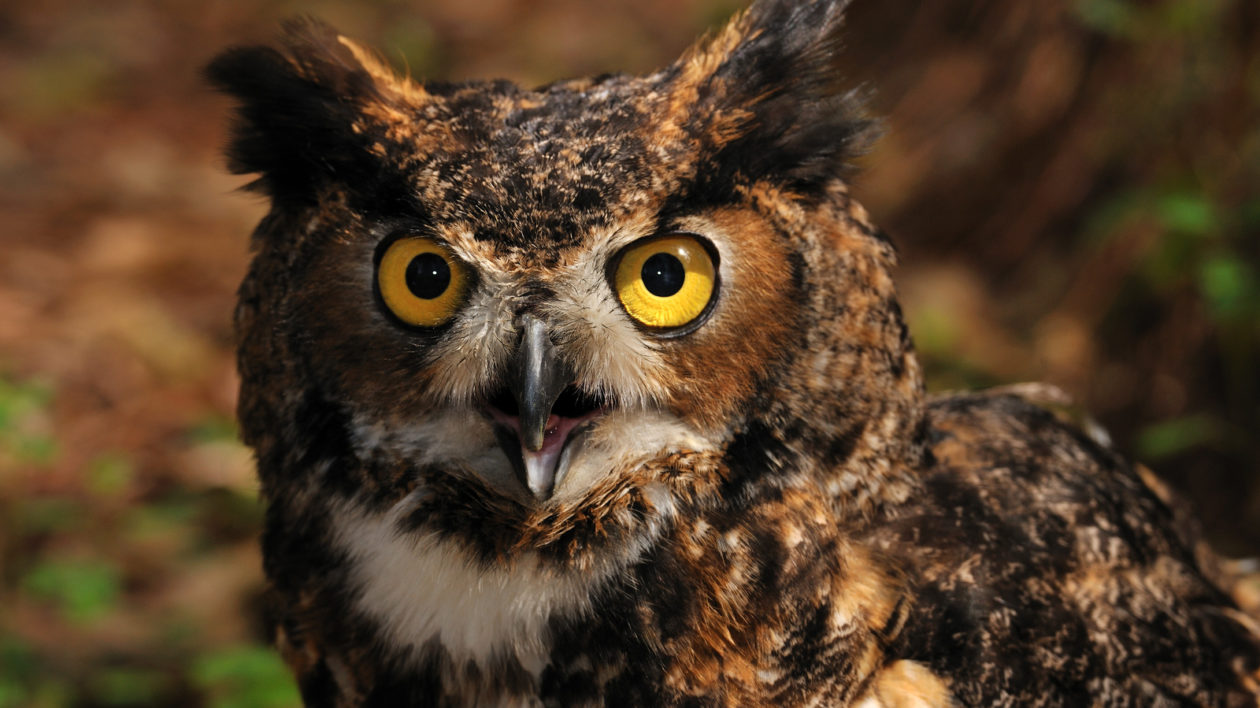
Photo © Mark Conlin, courtesy of Tallahassee Natural History Museum
My Owl Connection
Family lore holds that, long before I could utter words, I would lie in my crib and hoot like an owl. Perhaps my naturalist path was set, even then.
That story has been in my thoughts this year, as I prepare for the birth of my own son. The great horned owls, it seems, are everywhere. I see them perched on trees around our home and along the greenbelt jogging path; hear their calls in the canyons and river bottoms.
I’m always alert to the local wildlife, but this year, I can’t help but pay extra attention to all that owl activity.
I wake up in the middle of the night, thinking of my son and the world he’ll inhabit. And then, there it is: that deep hoot, hoot, hooting.
It seems to fill the room.
I snuggle under the covers and smile, filled with the hope that my son will find such comfort and joy in the wild things and their always-interesting ways.
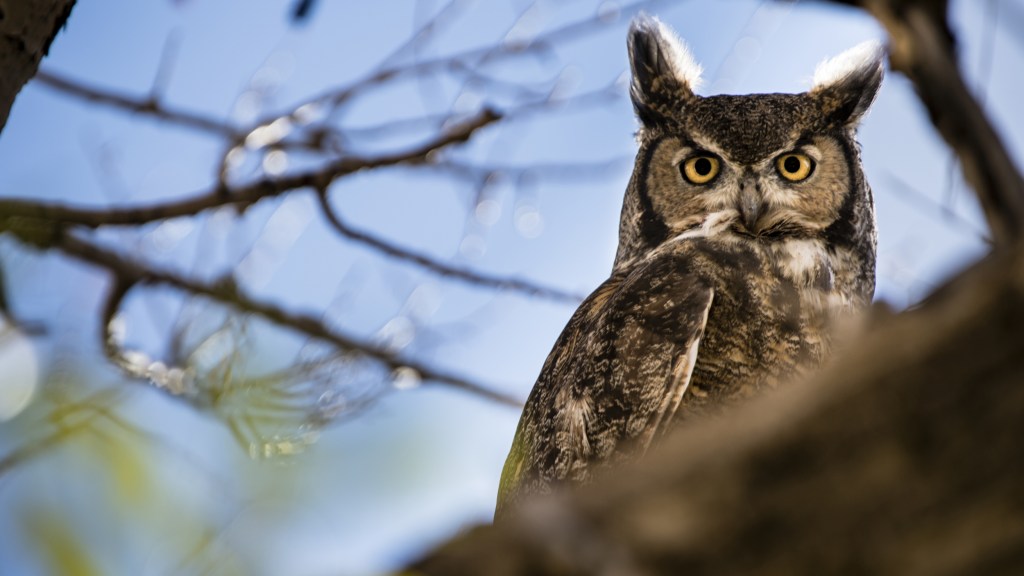



Wonderful story. I have a few questions. I have lived in my home with my mother for 15 years and never have we heard owls. This year around January 2016 WD started to hear the lovely songs of a owl hooting. We became more interested and started paying more attention and reading up on the amazing owls. One morning while leaving we saw it it flew directly on top of the barn next to my house and it was amazing. After that we have seen the owl a few more times. We are awaken every night between 12-2 and then 4-6 to hear the hoot hoot hooo. We are wondering if it’s a male or female and if it lives close as we would love to observe the owl while not disturbing it. We can hear this owl and it sounds like it’s right outside in the tree and then a faint call back witch seems to be about 7 blocks away. I’m wondering if u could answer a few questions or direct me in the right path. How large are the owls territory and if we hear the owl close is it most likely the owl is roosting close. And and all info will b greatly appreciated as we just want to learn as much as we can without disturbing the owl or owls. Thanks amber.
Hi Amber,
Many thanks for your comments and questions. Great horned owls are really fantastic birds, aren’t they? As far as the size of the owl’s territory: the territory size depends on density of prey in the area and also the owl population. If there is a lot of prey, owl territories are smaller. From your comment, it would appear you are in the midst of an owl territory but the nest could still be a fair distance away.
Female great horned owls are larger than males, but it can be hard to tell if you just see one. A pair shares a territory. Watch closely and you may see two owls, or hear them calling back and forth to each other.
Great horned owls are adaptable to humans — they can live in city parks, neighborhoods, farms, etc. Hopefully you will have many years of owl viewing near your home!
Matt
do the owls stop hooting by the end of February? I have been hearing 2 of them for 3 months and now all of a sudden they have stopped?
I wonder if you can answer a question for me. I have had Great Horned Owls nesting in the woods behind my house for the past 7 or more years. I love how the pair hoot and “sing” to each other. A couple of weeks ago I saw the pair in two tall adjacent pine trees hooting. I also saw 2 hawks circling the area. After that I have not heard the owls. I was wondering if they laid their eggs and are quieter now or if the hawks get into the eggs or something else.
I miss their hooting and hope all is well. For weeks I listen to them as I fall asleep. Last year I actually had one of the adults hunting in my yard while I heard the screeching of a hungry owlet.
My question is…Is is normal for the owls to go quiet while rousting on their nest? It is February in Michigan (Grand Rapids area) and I think they lay their eggs around now. I am concerned about my owls and hope they are ok.
Today, two owls adopted our cluster of Palm trees. They sat up there continuously for last 10 hours. I wonder if they are visiting or thinking about nesting in Sun Lakes, Arizona.
I live in West Grove PA
Southern Chester county
I layed in bed wondering what this noise was over and over, after some quick research, I found out that it is this Great Horned Owl that you have written about..
I have layed here for over an hour listening to him…
How fascinating….
One very late warm night here in NW Wisconsin, In late September ,,I enjoyed the company of a migrating Northern Saw-whet Owl. I was sitting out on my porch and a small owl alighted on one of the hangers for my pots of plants. I stayed very still watching him and soon he flew to a closer hanger. The dimmed outdoor house light over my shoulder provided just enough light to make out his beautiful feathers and intelligent eyes. Then he flew even closer as I remained still. We silently enjoyed watching each other for over an hour. What a great experience!
I live in a great little town in the central California coast called Nipomo. I live in a fruit orchard on the edge of a cops of Eucalyptus trees. Very large trees! There seem to be at least four owls that I have spotted and they are hooting daytime and night. I don’t remember this kind of frequency before. Sadly, I have noticed lost kitty posters posted in the neighborhood. Not LOST kitties.
Finding a great horned owl is on my bucket list.. I just love these incredible birds but have never been able to see one in the wild. I’ve heard them by my home in Sayville, NY.. Even went outside at 2am in my pajamas when I heard one across the street.. Couldn’t find it! It was probably watching me and laughing!
Hi Matt. Has it been definitively proven that Great Horned owls have no learning involved with hoots? This week I heard a mother owl and two of here fledged owlets, a male and a female. As I listened to the youngsters gargled hoots I heard them seem to improve into more reliable adult hoots. I know the mother’s hoots from over five years of listening. I also can recognize the younger male parent. The two youngsters were differentiable from each other by higher and lower tones. Am I just imagining or is this possible? Thanks for reading this, Rick.
In Long Island I might add!
I believe one of these lives in very close proximity to my house. Hoo-hoo-hoo-hoooooooo. I’ve been hearing that noise outside my window for years. I actually hear it from springtime throughout the entire summer. Could it be a great horned owl?
Hi L, It looks like Great Horned Owls do live on Long Island. See Cornell Lab of Ornithology’s page for the sounds they make and more information: http://www.allaboutbirds.org/guide/Great_Horned_Owl/sounds
Here’s a wonderful opportunity to get “up close” without endangering or disturbing these beautiful and majestic birds. I’m obsessed with this live feed of a nesting great horned owl on Skidaway Island, Georgia. http://www.georgiawildlife.com/landingsbirdcam. She has taken up residence in what was originally a bald eagle nest and is caring for two eggs.
Great info but very important to add that you should not get too close to the nest or disturb the owls in any way. If you are altering their behavior, you are disturbing them.
Awesome article. Please post if there’s any spottings in NYC area or Long Island My daughter would love to see them
Fantastic story and what a gift for your son to read some day 🙂